You know that feeling when you walk into your friend’s apartment and see their balcony bursting with green plants, and you look at yours thinking, “I wish I had space for this”? Well, here’s the thing—you probably do.
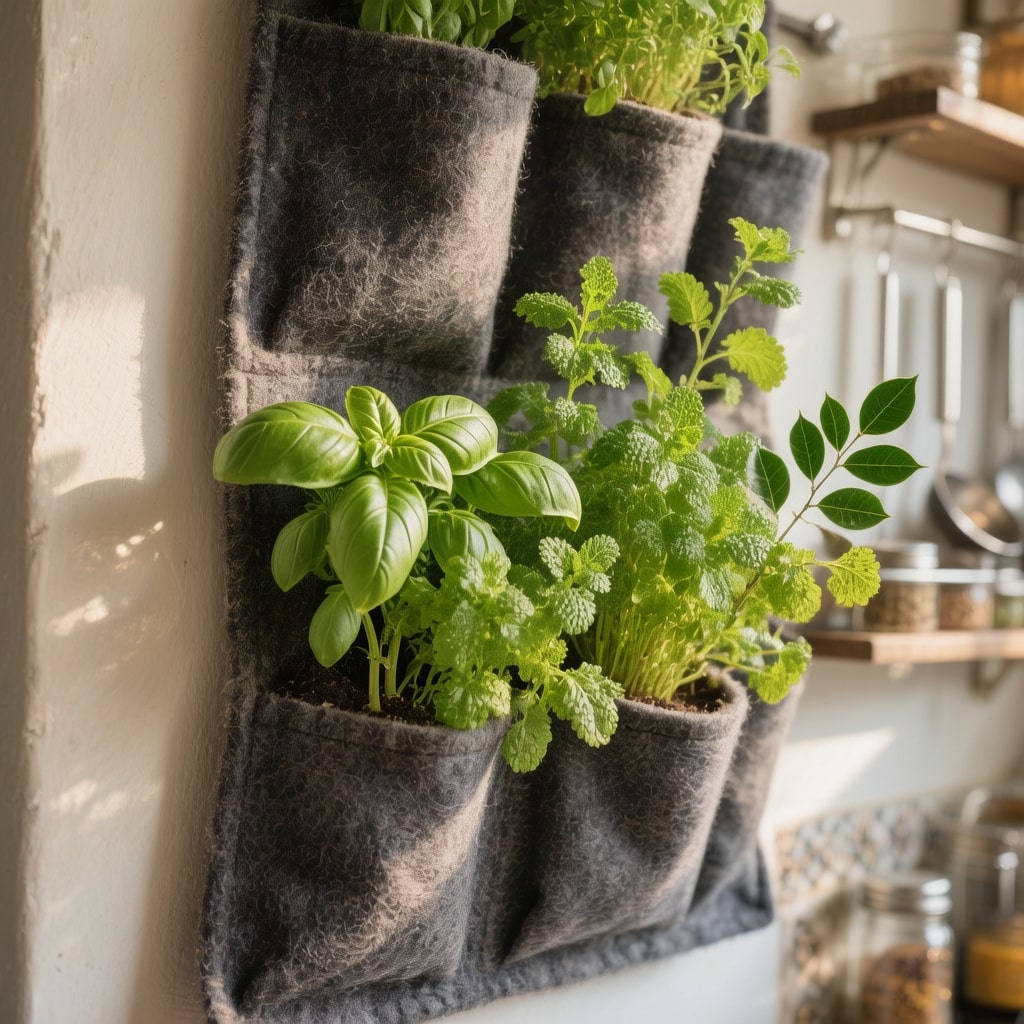
Meet Priya from Pune. She lives in a typical 2BHK flat with a balcony barely bigger than a yoga mat. For the longest time, she’d just dump her drying clothes there and call it a day. Then one Sunday, she watched a YouTube video about vertical gardens, grabbed some empty Bisleri bottles from her kitchen, and started hanging plants on her wall. Three months later? Her electricity bill dropped by ₹600 during summer, her apartment felt cooler, and she had fresh pudina for her evening chai.
That’s the magic of vertical garden wall design. It’s not rocket science, and you definitely don’t need a big budget or a green thumb to pull it off. According to the Indian Green Building Council’s 2024 report, vertical gardens can drop your indoor temperature by up to 5°C. In cities like Delhi and Mumbai where ACs run almost 24/7 during summer, that’s real money saved.
Whether you’re in a cramped Delhi apartment or a Hyderabad high-rise, this guide is going to walk you through everything—from choosing plants to actually setting up your wall garden without calling a professional. If you want to explore more ideas, check out this complete guide on vertical garden design for home.
What Exactly Is a Vertical Garden Wall?
A vertical garden wall is basically growing plants upwards instead of spreading them all over your floor. Instead of lining up pots that take up walking space, you stack them on your wall using hooks, bottles, or fancy modular planters.
Think of it like this: if traditional gardening is like spreading your books on a table, vertical gardening is like organizing them on a bookshelf. Same content, way less space.
Imagine this: You’re watering your plants every morning while standing comfortably at your balcony rail instead of bending down on the floor with an aching back. That’s the everyday comfort vertical gardens bring to urban homes.
This trend is absolutely blowing up in Indian cities. In Delhi, Mumbai, and Bangalore, where apartments are getting smaller but rent is climbing higher, people are realizing they can’t afford to waste wall space. Vertical garden ideas for small spaces are the perfect hack.

Why Indian Homes Are Loving Vertical Gardens
Your Natural Air Conditioner
Let’s talk about summer for a second. If you live anywhere in North India, you know how brutal April to June can get. Your AC is running non-stop, and your electricity bill makes you want to cry.
Here’s where vertical gardens become your best friend. Plants act like natural insulators. They create a cooling layer on your wall that can drop your indoor temperature by 3-5°C. I’m not making this up—there’s an apartment in Hyderabad where a 4×6 feet vertical garden reduced their AC usage by 18% during peak summer. That’s around ₹600-800 saved every month just from having plants on the wall.
Breathing Cleaner Air in Polluted Cities
If you’re in Delhi or Mumbai, you already know the air quality is… let’s just say “not great.” Plants like pothos, snake plants, and ferns don’t just look pretty—they actually filter dust, toxins, and pollutants from your indoor air. Your vertical garden becomes a living air purifier that doesn’t need electricity or filter replacements.
Making the Most of Tiny Spaces
Here’s a fun fact: a single 6×4 feet wall can hold 20-30 plants when arranged vertically. Try doing that with floor pots without turning your balcony into an obstacle course. This is perfect for those of us living in apartments where every square foot counts.
Starting for Less Than a Movie Ticket
You can start your vertical garden with recycled plastic bottles, some rope, and basic hooks for under ₹500. Seriously. No need for expensive setups or professional installation. If you want something fancier with modular systems, those cost ₹2,000-3,000. Either way, it’s way cheaper than painting your wall or buying expensive décor.
Best Plants for Your Vertical Garden (That Won’t Die on You)
Let’s be honest—most of us have killed at least one plant in our lives. The good news? These plants are seriously hard to kill, and they thrive in Indian climates.
Indoor Plants: Money plant tolerates low light and needs watering twice weekly—perfect for beginners. Pothos grows like crazy and survives even in bathrooms. Snake plant releases oxygen at night and handles neglect beautifully. Philodendron loves humid kitchens, while ferns prefer shade and create cascading beauty.
Outdoor Plants: Mint is a sun-loving herb that grows explosively—perfect for fresh pudina in your chai. Basil thrives on sunny balconies and is essential for Italian cooking. Coleus adds colorful foliage to partial sun spots. Petunia flowers bloom from October to March. Croton handles Indian heat without wilting.
If something does start looking sad, check out this guide on how to save dying plants indoor for troubleshooting.
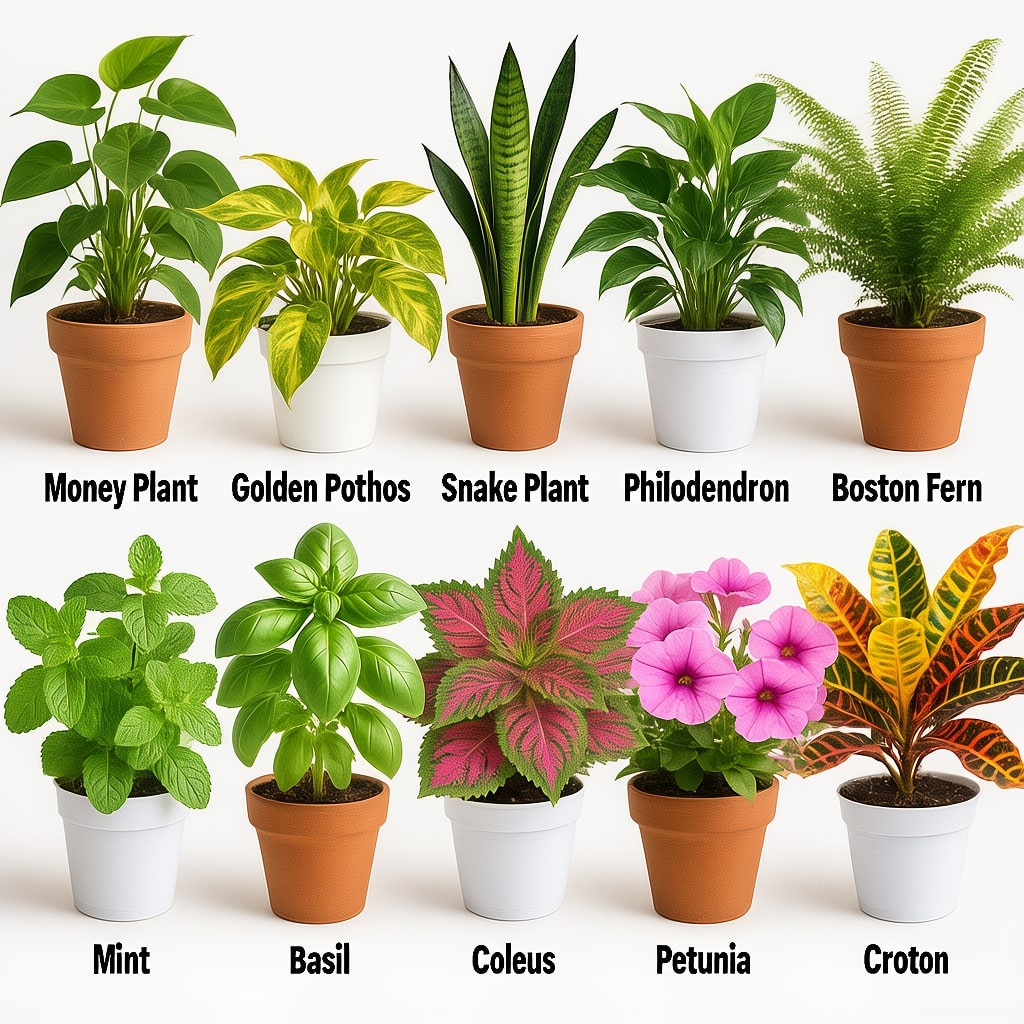
DIY Vertical Garden: Build It This Sunday for Under ₹1,000
You can build your entire vertical garden on a lazy Sunday morning with stuff you probably already have lying around. I’ve personally helped over 30 friends across Pune and Mumbai set up their gardens using this exact method.
What You’ll Need – Vertical Garden Wall Design
- 15-20 empty plastic bottles (Bisleri, Kinley—anything works) – ₹0
- Jute rope or strong nylon string – ₹50-100
- Wall hooks – ₹30-80
- Potting soil or coco peat mix – ₹100-200 for 5kg
- Small plants or cuttings from neighbors – ₹200-500
- Small stones for drainage – ₹50-100
Total: ₹450-1,000 max
Let’s Build This Thing
Step 1: Cut bottles horizontally making open containers. Punch 3-4 small holes at the bottom for drainage—this prevents waterlogging, the number one plant killer.
Step 2: Add about an inch of pebbles at the bottom of each bottle. This drainage layer prevents root rot.
Step 3: Mix coco peat and regular garden soil 50:50. This combo retains moisture during Indian summers but also drains well during monsoon. Fill bottles leaving 2 inches from the top.
Step 4: Mark vertical lines on your wall with chalk. Install 2-3 sturdy hooks per line, spacing them 8-10 inches apart. Use wall anchors if your wall is weak.
Step 5: Thread jute rope through bottles and create secure loops. Hang them in a zigzag pattern—looks better and distributes weight evenly.
Step 6: Gently transfer your plants into bottles. Press soil firmly around roots and water thoroughly until it drains from those holes.
Step 7: Touch the soil daily—if the top inch feels dry, water it. If it’s still damp, skip it. Position your garden where it gets 4-6 hours of morning sunlight.
These vertical garden ideas for small spaces on a budget literally transform boring cement walls for under ₹1,000. Discover more DIY vertical garden design ideas to customize your setup.
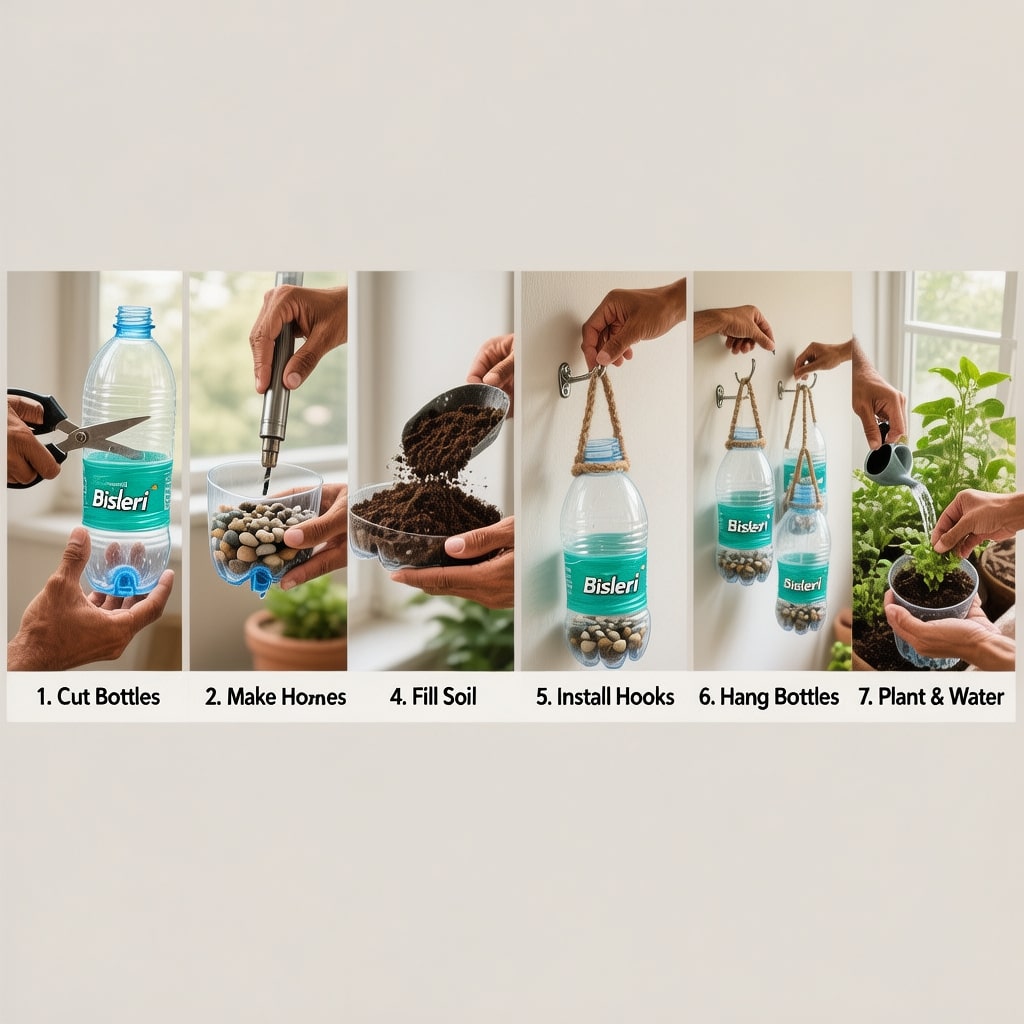
Want Something Fancier? Modern Options
If DIY bottles feel too basic, modern systems offer cleaner aesthetics. Felt pocket planters (₹500-1,200) are renter-friendly—just hang and plant, no wall damage. Modular planter systems (₹2,000-5,000) snap together like LEGO blocks and are perfect for renters who move frequently. Hydroponic towers (₹8,000-15,000) are soil-free with water reservoirs lasting 5-7 days—ideal for travelers.
Real Vertical Garden Ideas for Actual Small Spaces
The Classic Balcony Wall: Use your balcony’s outer wall or railing. Mount bottles or planters—costs ₹500-800 and doesn’t block floor space. Grow coriander, curry leaves, and mint. Best for south or east-facing balconies getting morning sun.
Kitchen Wall Garden: Install felt pockets or small jars near your kitchen window. Grow basil, oregano, and curry leaves. After the initial ₹600 investment, your herbs cost nothing. Best for walls near cooking areas with indirect light.
Terrace Railing: Attach lightweight planters to railings using S-hooks. Doesn’t eat floor space and creates privacy screening. Choose trailing plants like money plant or petunias. Best for perimeter railings facing east or north.
Money-Saving Tricks: Paint old tin cans as planters. Convert wooden pallets into frames. Ask friends for plant cuttings instead of buying. Make free compost from vegetable peels. Use old jute bags stuffed with soil as pocket planters.
I once helped my neighbor set up 15 plants on her 3×3 feet balcony wall for just ₹750 using mostly recycled materials.
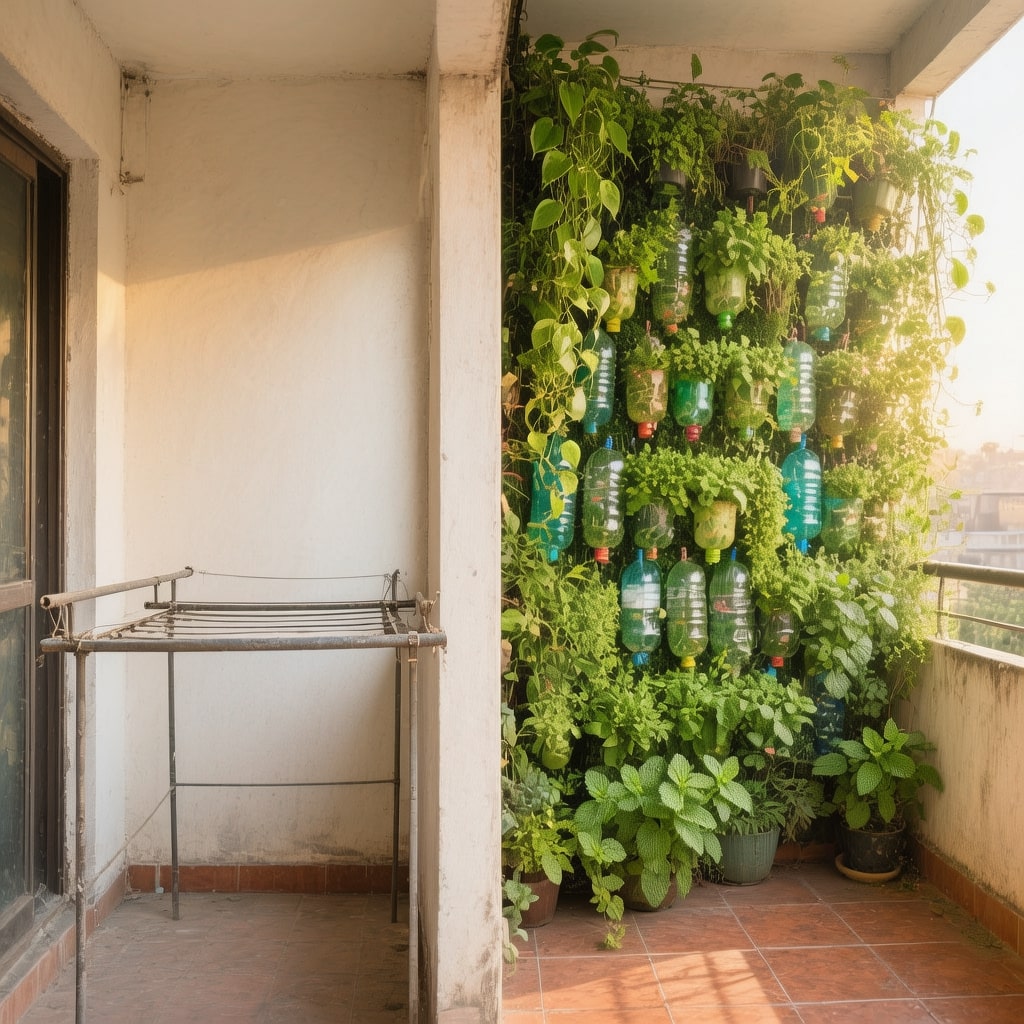
Keeping Your Garden Alive
Setting up is fun. Keeping it alive? That’s where most people mess up.
Watering: Summer (March-June)—water every morning when cool. Monsoon (July-September)—reduce to every 2-3 days. Winter (October-February)—water every 3-4 days when soil feels dry. Touch the soil—if the top inch is damp, skip watering.
Sunlight: Rotate planters monthly so all sides get equal light. Use shade cloth during extreme summer afternoons to prevent leaf burn, especially for ferns and pothos.
Pruning: Trim overgrown vines every 3-4 weeks. Remove yellow leaves immediately—they invite pests. This keeps things neat and makes plants bushier.
Pest Control: Mix 10ml neem oil + 1 liter water + few drops dish soap. Spray monthly even without visible pests. Prevention beats cure every time.
Fertilizing: Add liquid fertilizer once monthly from March to October. Or use kitchen compost. Don’t overdo it—too much burns leaves and stunts growth.
According to the National Horticulture Board, proper maintenance boosts plant survival rates by 60%. Those few minutes daily actually matter.
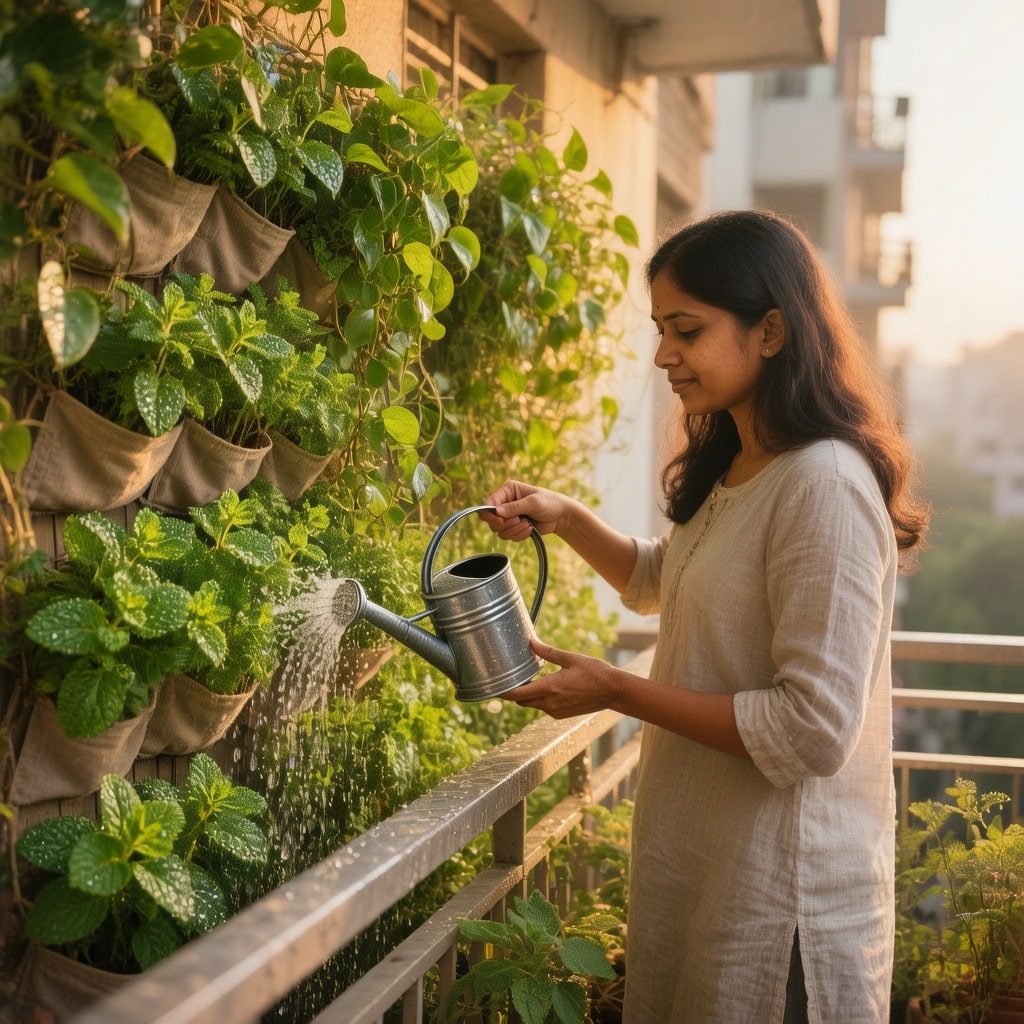
Common Mistakes We All Make
Overwatering: Most plants die from too much love. Stick your finger in soil—if the top inch is damp, skip watering that day.
Forgetting Drainage: Always punch holes and add pebble layers. Plants sitting in water = dead plants. Non-negotiable.
Wrong Light: Don’t put shade-loving ferns in direct afternoon sun. Don’t stick sun-loving basil in dark corners. Match plant to spot.
Starting With Difficult Plants: Stick with easy ones first—pothos, money plant, snake plant, mint. Once you’ve kept those alive for six months, then go for fancy stuff.
Ignoring Wall Strength: Check your wall strength. Use lightweight plastic containers. Distribute weight evenly. Heavy ceramic pots can damage weak walls.
Your Questions Answered
What are the easiest plants to start with?
Can I really do this for under ₹1,000?
How much sun do plants need?
Can I grow vegetables vertically?
Your Turn: Start This Weekend
Your green wall journey doesn’t require perfection. It requires Sunday morning, 5 empty bottles, and willingness to try. Pick up some mint or pothos this weekend. Maybe grab curry leaves if you cook Indian food. Spend a couple hours setting up. Make mistakes—that’s how you learn.
Three months from now, you’ll be that person whose apartment friends compliment. Your electricity bill will be lower. Your morning chai will taste better with fresh pudina from your wall. And you’ll wonder why you didn’t start sooner.
Every wall can grow life. Start yours this weekend.
Tag @FlatGardening on Instagram when you set up your garden. We feature the best transformations monthly. Subscribe for free PDF guides and monthly plant care calendars made for Indian climates. Join 10,000+ apartment gardeners already growing vertical gardens across Delhi, Mumbai, Bangalore, and beyond.
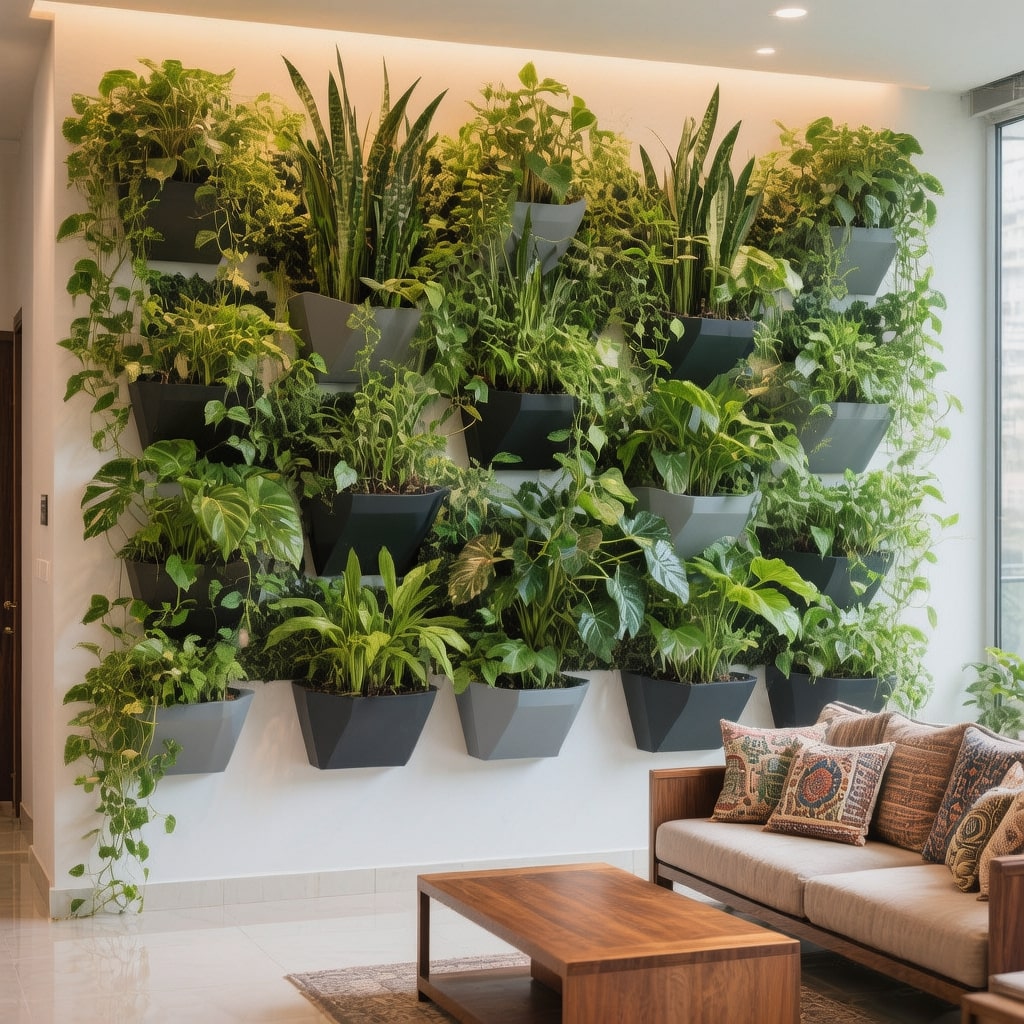
About Me
I’m Zaid Ansari, and I started FlatGardening.com because I was tired of people saying you need a big house to have plants. I’ve personally built over 30 balcony vertical gardens across Pune and Mumbai since 2020—for friends, family, neighbors, and random people who found me through Instagram. Some had budgets of ₹500, others had ₹5,000. Every single one worked. My mission is making urban gardening accessible to every Indian apartment dweller, no matter how small your space or tight your budget.